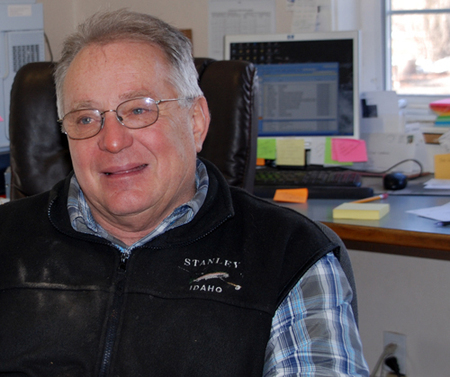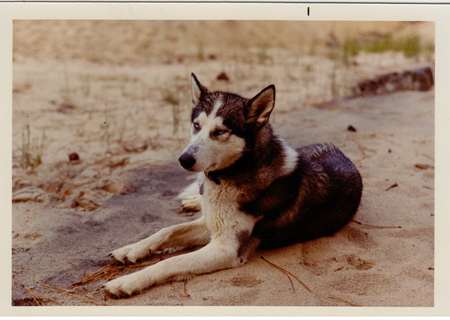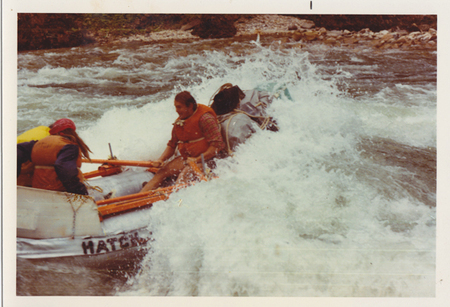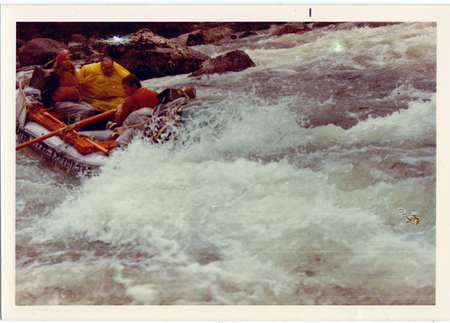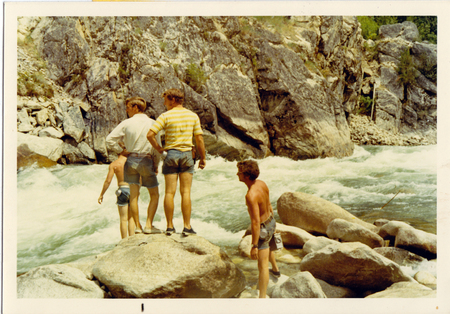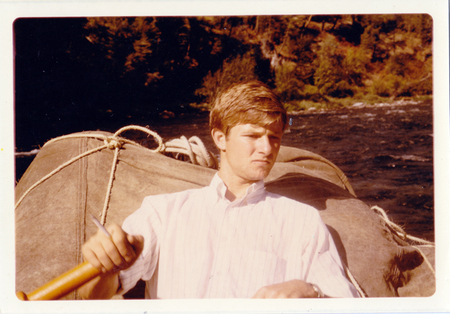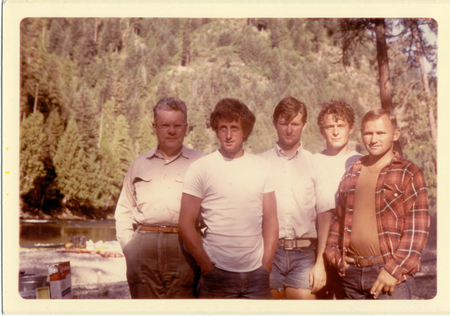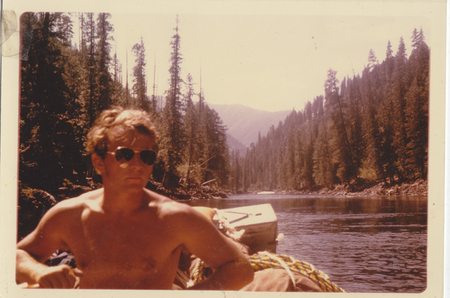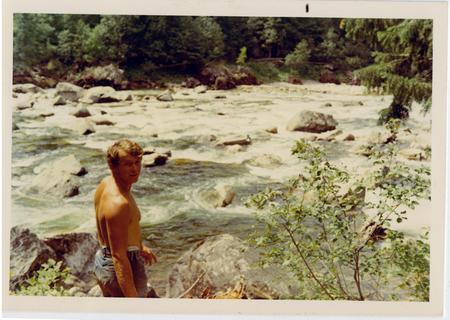Episode 5 : Whitewater on the Selway River : an interview with Jerry Hughes Item Info
The Selway River runs all the way through the wilderness and is one of the area’s main attractions. Technically difficult, with a limited launch season, the Selway is the most coveted wild river to run in the lower 48 states. In this episode, titled “Whitewater on the Selway River,” we meet Jerry Hughes, the owner of Hughes River Expeditions, who has worked as a river guide since 1966 and an outfitter since 1976. From an early age, Jerry knew he wanted to work on Idaho’s rivers. While in college, he rowed for Hatch River Expeditions, where he helped pioneer the early Selway river trips, just after the passage of the Wild and Scenic Rivers Act. Later, he and his wife, Carole Finley, started their own river business, taking guests down some of the most exciting rivers in the northwestern United States. Listen as Jerry tells stories of working as a boatman and guide on some of the earliest outfitter trips down the Selway River.
Episode 5 : Whitewater on the Selway River : an interview with Jerry Hughes [transcript]
00:00:00:00 - 00:00:29:07 Debbie Lee or Jane Holman: Welcome to the Subway Bitterroot Wilderness History Project, which is made possible by a grant from the National Endowment for the Humanities. The University of Idaho, and Washington State University. Part of the project’s mission is to collect, preserve, and make public oral histories documenting the history and people of the subway. Bitterroot wilderness. For more information, please visit our website at SPW lib argue idaho.edu.
00:00:29:10 - 00:00:54:07 Debbie Lee or Jane Holman: And then I think people, I think people get so much out of being in a wilderness setting once you take away cars and money and telephones, people are different and they are different to each other, I think. And, and, and then they draw on things in themselves that maybe are a little rusty from our crazy life out here.
00:00:54:07 - 00:01:25:07 Debbie Lee or Jane Holman: Now, I think the ways that people get along when they’re isolated in a place like that, that they place that they want to be, are really it’s a wonderful thing.
00:01:25:09 - 00:01:59:15 Debbie Lee or Jane Holman: Thank you for joining us for the fifth episode of the South Bitterroot Wilderness History Project. The Selway River runs all the way through the wilderness and is one of the area’s main attractions. Technically difficult with a limited launch season, the Selway is the most coveted wild river to run in the lower 48 states. In this episode, titled White Water on the snowy River, we meet Jerry Hughes, the owner of Hughes River expeditions, who has worked as a river guide since 1966 and an outfitter since 1976.
00:01:59:17 - 00:02:23:19 Debbie Lee or Jane Holman: From an early age, Jerry knew he wanted to work on Idaho’s rivers. While in college, he rode for hatch River expeditions, where he helped pioneer the early Selway River trips. Just after the passage of the Wild and Scenic Rivers Act, later, he and his wife Carol Findley started their own river business, taking guests down some of the most exciting rivers in the northwestern United States.
00:02:23:21 - 00:02:31:20 Debbie Lee or Jane Holman: Listen as Jerry tells stories of working as a boatman and guide on some of the earliest outfitter trips down the Solway River.
00:02:31:22 - 00:02:38:28 Debbie Lee or Jane Holman: Okay, Jerry, so tell us a little bit about your background, and then maybe go to how you got connected with the Solway River.
00:02:39:01 - 00:03:06:07 Jerry Hughes: Sure. I was born in 1947, in southern Idaho. my family, extended family, were farm families, and my mother was a schoolteacher. My dad worked in agriculture and, was raised in Hazelton, Idaho. And as a young kid, I was watching a TV show that showed a Don Smith running a raft down the middle fork. And I announced to my mother and my big sister, Roberta, that I was going to do that.
00:03:06:10 - 00:03:27:17 Jerry Hughes: And Roberta, of course, laughed at me and made fun of me. And we got in a fight and, I the summer of 67, I got a job guiding for hatch River expeditions. That was the summer. The bus hatch passed away and his sons, Don and Ted took over the business. And, I worked for Don and Ted for seven summers.
00:03:27:19 - 00:03:48:11 Jerry Hughes: from 1967 through 73, while I was going to to, college and law school at University of Idaho. And, the way I got up to the Selway was kind of blind luck. 67 was the first year of the hatch. or really, I think any of the river companies actually showed up and took people down the Solway River.
00:03:48:13 - 00:04:07:19 Jerry Hughes: And the hatch boats were old military surplus tenements. And so down the river we went on extraordinarily low water. I never ran the Selway Lower. In the years that I worked there than on that first trip. And we had seven days because Don wanted to make sure that we could make our way down the river slowly and scout and take our time.
00:04:07:21 - 00:04:25:28 Jerry Hughes: And, I remember really having to push the boats until we we made it down through the first couple of days. We were stuck in the rocks almost constantly. But but we had a great trip. And, some of my memories of that trip were I’d never seen rattlesnakes that short and that fat, and they were everywhere, it seemed like, especially on the upper river.
00:04:26:01 - 00:04:46:00 Jerry Hughes: It was the first time I’d ever personally guided with Dawn and Dawn, and I really hit it off. And we became great friends. And, I got to boat several times with Don on the. So in later years, we, finished the trip up and, Don just felt like he’d gone to heaven. He loved the. So he’d always been a little short guy.
00:04:46:02 - 00:05:18:01 Jerry Hughes: He loved the Milford work, and he loved the green River. The door kind of small rocky rivers. But the subway instantly became his favorite river. And, it was neat to go with Don hatch because the guy was undoubtedly the best boatman I ever followed in my life. Don would just sit on his boat and it would go where it was supposed to go without any or strokes, and the rest of us would be following along behind him, rolling back and forth and spinning around and doing spins and but but Don hatch was just such a gentleman, and he always was so proper.
00:05:18:01 - 00:05:36:15 Jerry Hughes: He always combed his hair and he wore a Oxford button down shirt with Levi blue jeans and high top Chuck Taylors. And he was just quite a gentleman and, loved to camp cook. And I got to really kind of learn how to be a river camp cook, working with Don on, on those early trips.
00:05:36:17 - 00:05:45:26 Debbie Lee or Jane Holman: So how is the Solway? You said that Don hats. That was his favorite river. How is the so different from some of the other rivers you’ve run?
00:05:46:01 - 00:06:04:27 Jerry Hughes: I’m sure the reason Don liked it was is very technically difficult on the flows that we used to run it. We always ran medium water down through medium low water and that that water condition on the. So it means that it’s a Bowman’s river. You’re dodging around and having to make tight fits through rocks and and there’s a steep gradient.
00:06:04:27 - 00:06:26:06 Jerry Hughes: So you’re always you always have something going on. you don’t just sit on the boats and cruise through flat water. You’re always busy. And the rapids, the other fun thing is the rapids really change. They’re extremely tight and technical on the upper end of the river. Then by the time you’re down below Moose Creek, you’ve got a bit of volume that you’re starting to get some real, real punch to the river from, from increase volume.
00:06:26:08 - 00:06:52:22 Jerry Hughes: And, it’s just the style of river that that Idaho boatmen absolutely love. it’s busy and and tricky all the way. also, Don love the cool weather. He loved pine trees. he loved the crystal clear water. And I think probably the signature deal of the Middle Fork in the Selway has to be that crystal clear water, which you don’t find anywhere else that I know of.
00:06:52:22 - 00:07:13:22 Jerry Hughes: In in the, you know, in the boating world. the Solway in the Middle Fork of the salmon are just extraordinary for that. we, would come back and run the survey once or twice, occasionally three times a summer. during the rest of the years that I was there with hatch. And during the seven years I worked for hatch.
00:07:13:24 - 00:07:37:17 Jerry Hughes: I manage I think we missed 1 or 2 years due to higher water or no reservations, but I managed to do the first nine trips that hatch did on the Selway during those seven years. And, I just loved it. Well, Wolf Creek was the most dramatic drop by far. And then probably the most difficult rapids, I think, would be Osprey and Lail.
00:07:37:19 - 00:07:57:26 Jerry Hughes: I’ve never been in there on high water because Don was so cautious about high water in the days I worked for him. So I’ve never seen moose juice when it really takes off. When you get all the flow out of out of Moose Creek. And but my friends like Mel and Larry and the guys that work there for Don, that they gradually boated higher and higher water and they, you know, we’re able to deal with it.
00:07:58:03 - 00:08:29:00 Jerry Hughes: But I guess that thing becomes a just a almost a continuous class for plus rapid. As the water goes up, double drop and ladle and little Niagara and all that stuff, and they just run together. And so it must be really impressive. I have never seen it on the higher flows. I only ran relatively modest flows. In fact, one of the fun, more water stories about working for Don was my, a last year, 73, which was a low water year across Idaho.
00:08:29:02 - 00:08:47:05 Jerry Hughes: We had three spillway trips planned, so I got to go on all three. But the last trip I went on and so when I guided for for Don was 60 or 73 and we flew into the Running Creek Ranch to launch, which is kind of a fun little twist. And I think I’ve understood that, that they decided they didn’t want that air traffic.
00:08:47:12 - 00:09:10:22 Jerry Hughes: And so they they didn’t do that often, if at all, in the future. After that, the spillway was just so extraordinary. We were so excited to have the opportunity to boat it, and we realized that hardly anybody was getting the boat. It yet. Yeah. Looking back on it, even though we value that, that time on the river so much, I don’t think we probably even properly valued the fact that we were there really early on.
00:09:10:22 - 00:09:27:22 Jerry Hughes: And, and, that we got the chance to do what we did. you know, one of the interesting things I remember is, is, river camping was so primitive in those days. And of course, we people just went out and went to the bathroom anywhere they could. And we had a shovel, and you’re supposed to cover things up.
00:09:27:25 - 00:09:45:03 Jerry Hughes: And we used to bury our garbage, and then we’d come back to the camp the next week or the next year, and all the garbage would be dug up. Of course, you know, a bear would have gotten into it. And we we were really surprised that that, you know, oh, I wonder why that happened and, talk about but, you know, not thinking ahead.
00:09:45:05 - 00:10:09:18 Jerry Hughes: And within those early years of working in Idaho, the Forest Service, especially on the Middle Fork, told us, hey, it’s time to start carrying out garbage. And I think all the River guides reaction was that we can’t possibly do that. Well, you know, now, of course, we’re we’re not only carrying out garbage, but but we’re, we’re, you know, usually everybody’s using fire pans and carry out toilets and, and the river thing has changed so dramatically.
00:10:09:22 - 00:10:18:24 Jerry Hughes: And the river camps are so much better for it. but, those early days were, were kind of interesting.
00:10:18:26 - 00:10:42:29 Debbie Lee or Jane Holman: Thank you for joining us for this episode of the Selway Bitterroot Wilderness History Project, which has been made possible by the National Endowment for the Humanities. The University of Idaho, and Washington State University. The project coordinator is Debbie Lee, recorded and produced by Aaron Jepson.
Gallery
- Title:
- Episode 5 : Whitewater on the Selway River : an interview with Jerry Hughes
- Creator:
- Debbie Lee; Jane Holman; Jerry Hughes
- Date Created (ISO Standard):
- 2011-03-22
- Description:
- Interview with: Jerry Hughes | Interviewers: Debbie Lee and Jane Holman | Location: Cambridge, Idaho | Date: March 22, 2011 | TOPIC: Whitewater on the Selway River | In this episode, titled 'Whitewater on the Selway River,' we meet Jerry Hughes, the owner of Hughes River Expeditions, who has worked as a river guide since 1966 and an outfitter since 1976.
- Subjects:
- podcasts boats rapids river guides river policy
- Section:
- Wilderness Voices
- Location:
- Selway-Bitterroot Wilderness (Idaho and Mont.)
- Publisher:
- Wilderness Voices, The Selway-Bitteroot Wilderness History Project, https://selwaybitterrootproject.wordpress.com/
- Original URL:
- https://selwaybitterrootproject.wordpress.com/2011/04/20/whitewater-on-the-selway-river/
- Source Identifier:
- Selway-Podcast-ep5
- Type:
- Sound
- Format:
- audio/mp3
- Language:
- eng
- Preferred Citation:
- "Episode 5 : Whitewater on the Selway River : an interview with Jerry Hughes", The Selway-Bitterroot Wilderness History Project, University of Idaho Library Digital Collections, https://www.lib.uidaho.edu/digital/sbw/items/sbw287.html
- Rights:
- Copyright: The Selway-Bitteroot Wilderness History Project. In Copyright - Educational Use Permitted. For more information, please contact University of Idaho Library Special Collections and Archives Department at libspec@uidaho.edu.
- Standardized Rights:
- http://rightsstatements.org/vocab/InC-EDU/1.0/

